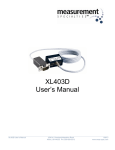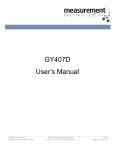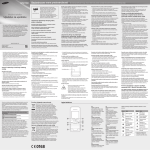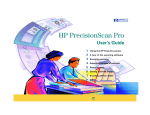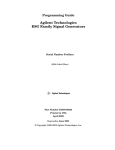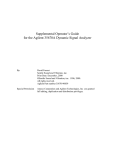Download Agilent Technologies 35670A Service manual
Transcript
Agilent 35670A Dynamic Signal Analyzer Versatile two- or four-channel high-performance FFT-based spectrum/network analyzer 122 μHz to 102.4 kHz 16-bit ADC Product Overview The Agilent 35670A shown with four channels (Option AY6) The Agilent 35670A is a portable two- or four-channel dynamic signal analyzer with the versatility to be several instruments at once. Rugged and portable, it’s ideal for field work. Yet it has the performance and functionality required for demanding R&D applications. Optional features optimize the instrument for troubleshooting mechanical vibration and noise problems, characterizing control systems, or general spectrum and network analysis. Take the Agilent 35670A where it’s needed! Whether you’re moving an instrument around the world or around the lab, portability is a real benefit. Small enough to fit under an airplane seat, the 35670A goes where it’s needed. But there’s more to portability than size. Like a nominal 12- to 28-volt DC power input and self-contained features that do not require external hardware, such as built-in piezoelectric integrated circuit power supply, analog trigger and tachometer inputs, and optional computed order tracking. Versatile enough to be your only instrument for low frequency analysis With the 35670A, you carry several instruments into the field in one package. Frequency, time, and amplitude domain analysis are all available in the standard instrument. Build on that capability with options that either add new measurement capability or enhance all measurement modes. AY6 1D0 1D1 UK4 1D2 1D3 1D4 1C2 100 1G0 Add two channels (four total) Computed order tracking Real-time octave measurements Microphone adapter and power supply Swept-sine measurements Curve fit and synthesis Arbitrary waveform source Agilent Instrument BASIC 1D0 – 1D4 bundle DataLink data transfer solution Key Specifications Frequency 102.4 kHz 1 channel range: 51.2 kHz 2 channel 25.6 kHz 4 channel Dynamic 90 dB typical range: Accuracy: ±0.15 dB Channel ±0.04 dB and ±0.5 match: degrees Real-time 25.6 kHz/1 channel bandwidth: Resolution: 100, 200, 400 & 800 lines Time > 6 Msamples capture: Source Random, burst types: random, periodic chirp, burst chirp, pink noise, sine, swept-sine (Option 1D2), arbitrary (Option 1D4) Agilent 35670A Dynamic Signal Analyzer Versatile measurement modes Agilent Instrument BASIC (Option 1C2) Develop a custom user-interface, integrate several instruments and peripherals into a system using the 35670A as the system controller, or simply automate measurements. • • • • • • • Standard and optional measurement modes include: FFT analysis Real-time octave analysis (Option 1D1) Order analysis (Option 1D0) Swept-sine (Option 1D2) Correlation analysis Histogram analysis Time capture All measurement options may be retrofitted. RPM display Read RPM in any measurement mode Powerful markers • • • • • • • • • • Extract information from measurement data with trace and special markers: Individual trace Coupled trace Absolute or relative Peak search Harmonic Band Sideband power Waterfall Time parameter Frequency and damping Built-In 3.5 inch flexible disk drive Store instrument states, programs, time captured data, waterfall data, trace data, limits, math functions, data tables, and curve fit/synthesis tables. Supported disk formats are HP-LIF and MS-DOS®. Internal RAM may also be formatted as storage disk. Shown with Option AY6 – add two channels Online help Precision measurements Applications oriented help is just a few keystrokes away. • • Large 6.3 inch (17 cm) display • Display area is not compromised by portability. • 2 Input channels • 16-bit ADC Analog A-weighted • ±0.15 dB spectrum amplitude accuracy filters (switchable) • ±0.04 dB, ±0.5 Transducer degrees channel sensitivity input match (full scale) Engineering units: • 90 dB dynamic range g, m/s2, m/s, m, (typical) in/s2, in/s, in, mil, kg, dyn, • 130 dB dynamic range with swept-sine lb, N, and pascals (Option 1D2) Built-in 4 mA • Up/down autorange constant current • Up only autorange power supply Math functions Powerful math and data editing functions to quickly modify measurement results. (Curve fit and frequency response synthesis available with Option 1D3.) Source types • • • • • • • Random noise Burst random noise Periodic chirp Burst chirp Pink noise Fixed Sine Arbitrary waveform source (Option 1D4) • Swept-sine source (Option 1D2) Note: The source is located on the front panel of a standard twochannel 35670A. GPIB connector Parallel port Integrate the 35670A with other instruments for system operation. System controller for GPIB (IEEE-488.1 and 488.2) compatible instrumentation via Agilent Instrument BASIC (Option 1C2). Print to older HP-GL printers with PCL 5 capability, such as an HP LaserJet 4000 series. DC power Low noise fan Accepts 12 to 28 volts dc (nominal). Use the 35250A power cable for DC power source connection, or the 35251A power cable with cigarette-lighter adapter. Fan may be turned off for acoustic applications. Running speed depends on ambient temperature. Serial port AC power External trigger Tachometer Power select (42 Volt peak max) No external signal conditioning hardware required. Triggers on selected level between ±10 Volts. (42 Volt peak max) No external signal conditioning hardware required. Reads frequency (RPM) on selected levels between ±20 Volts. Switch between AC and DC power sources without interrupting instrument operation. Keyboard External monitor Use a standard PC keyboard to title data, edit Agilent Instrument BASIC programs, or to operate the instrument. Drive a VGA monitor for remote viewing by large groups. 3 Universal power supply will operate with any combination of voltage between 100 and 240 VAC and line frequency between 47 and 440 Hz. The maximum power requirement is 350 VA. Spectrum Analysis Laboratory-quality measurements in the field Obtain all of the performance of your bench-top analyzer in a portable instrument. Ease-of-use Portability, versatility, and performance are valued attributes, but to be really valuable an instrument must also be easy to use. The 35670A has a friendly front panel, plus online help that’s always available to answer your questions. An interactive measurement state lets you configure the instrument setup from a single display. FFT-based spectrum analyzers, such as the 35670A, are ideal for measuring the spectra of low-frequency signals like speech or mechanical vibration. Transient components, usually missed with swept-frequency analyzers, are easily measured and displayed at speeds fast enough to follow trends. The 35670A has both the performance and features required to take full advantage of this technology. 16-bits for high performance With a 16-bit ADC (90 dB typical dynamic range) and a real-time bandwidth of 25.6 kHz, you can be sure nothing will be missed. Resolve signals using 100 to 1600 lines resolution, or for really close-in analysis, use frequency zoom to resolve signals with up to 61 µHz resolution. Use time or RPM arming to develop waterfalls of sequential vibration spectra for trend analysis or for an overview of device vibration. Power and linear spectrums Match your spectrum measurement mode to the signal being tested. Use linear spectrum analysis to measure both the amplitude and phase of periodic signals such as the spectra of rotating machinery. Power spectrum analysis is provided for averaging nonrepetitive signals. Two spectrums of road induced vibration measured at different speeds are compared using the front/back mode of the Agilent 35670A. 4 Averaging Various averaging modes let you further refine spectrum analysis measurements. Time averaging extracts repetitive signals out of the noise while rms averaging reduces the noise to its mean value. Exponential averaging, available for both time and rms averaging, is useful for reducing the noise while following changing signals—tracking the resonance shifts in a fatiguing structure for example. Time domain Special markers Use your spectrum analyzer as a low-frequency oscilloscope or view signals in the time and frequency domains simultaneously. Three special marker functions facilitate analysis of your spectral data. Sideband markers aid analysis of modulation signals. Use this function to quickly locate sidebands in (Note: anti-alias filters can be switched off.) Special markers for time-domain data facilitate extraction of key control system performance parameters: overshoot, rise time, setting time, and delay time. the complicated spectra of rotating machines. A band-power marker reads the total power in a selected band of frequencies and a total harmonic distortion marker lets you calculate total harmonic distortion without including the effects of noise. Simultaneous display of frequency and time domain data facilitates analysis of gear mesh vibration. Data table Use a tabular format to keep track of key frequencies in the spectra of rotating machinery. The amplitude and frequency of the signal and a 16-character entry label field are listed for each selected point. Automatic units conversion Measurement results at key frequencies can be labeled and listed using data table. Display vibration data in the units of your choice. Select g, m/sec2, in/sec2, m/s, in/s, m, mil, inch, Kg, lb, N, dyn, or pascals as appropriate for your application. The instrument automatically converts frequency-domain data from specified input transducer units to the units you select for display. For example, accelerometer data is automatically converted and displayed as mils when mils are selected. Of course, dB, dBV, dBm and volts are available for electrical applications. Harmonic markers are used to calculate the THD of a signal without including the effects of noise. Markers Markers streamline analysis by helping you select and display specific data. Marker functions include marker to peak, next right peak, and coupled markers for selecting points in multiple data displays. Markers readouts are absolute or relative to your selected reference. 5 Frequency Response Measurements The 35670A has the flexibility to make measurements of both electrical networks and mechanical devices. FFT-based network analysis is fast enough to allow real-time adjustments of circuit parameters while the swept-sine option provides exacting measurements over more than six frequency decades, and a 130 dB dynamic range. Source Four channels (Option AY6) Markers Test up to three devices simultaneously with a four-channel 35670A. Channel one is the common reference channel and two, three, and four are the response channels. Alternatively, select channels one and three as reference channels for two totally independent network measurements. See Option AY6 description for more information. A frequency and damping marker provides the resonant frequency and the damping ratio of single-degreeof-freedom frequency response measurements. Select the optimum stimulus for each application—random noise, periodic chirp, pink noise, fixed sine, burst random, and burst chirp. For zoomed network analysis measurements, the source is band-translated to match the zoom span at frequencies up to 51.2 kHz. An optional arbitrary source lets you test your product using realworld signals. A ±10 Volt DC source offset facilitates tests of control systems. Gain and phase margin markers extract key frequency-domain stability data from frequency response measurements of control systems. Limits are used for go/no go testing in production. The response of an accelerometer is being checked in this example. Impact testing Force and exponential windows allow impact testing for modal and structural analysis. Quality measurements are ensured using preview and accept/ reject during averaging. A 4 mA constant current transducer power supply is built-in for true portability. Characteristics of a selected resonance are automatically calculated from an impact measurement using the frequency and damping marker. Limits Test network measurements against preset limits. Up to 800 separate line segments are available for setting upper and lower limits. Limits are also used for testing spectrum measurements. 6 Time Capture Capture transient events or time histories for complete analysis in any measurement mode (except sweptsine). Use either the entire timecapture record or a selected region of interest for repetitive analysis in the FFT, octave, order track, correlation or histogram instrument modes. An interval of time-capture data has been selected for analysis in the octave mode. Standard 16 Mbytes of memory for deep time-capture capability. 7 Using Measurement Results Computed Order Tracking (Option 1D0) Taking the measurement is only half the job. Raw measurement data must be stored, recalled, printed, plotted, integrated with other data for analysis, and reported. The 35670A helps you finish the job. Entire display screens can be imported directly into your word processing program by plotting HP-GL files to your named DOS file. HP-GL files are interpreted and displayed directly by Microsoft’s Word for Windows. Documented results For general digital signal processing and filtering, data files may be stored as ASCII, and then imported to MATLAB® or a Microsoft® Excel spreadsheet via the floppy drive, DataLink, or GPIB. • Self-contained—no ratio synthesizer or tracking filter required • Order maps • Order tracking • RPM or timetrigger • Display RPM profile • Track up to five orders/channel • Up to 200 orders • Composite power • RPM measurements The 35670A supports GPIB, serial and parallel printers and plotters for direct hardcopy output. The printers and plotters that can be connected directly to the 35670A are limited to older HP-GL printers with PCL 5 capability (HP LaserJet 4000 series is one such printer). The internal 3.5 inch flexible disk drive stores data (Standard Data Format – SDF or ASCII), instrument states, HP-GL plots and Agilent Instrument BASIC programs in HP-LIF or MS-DOS formats for future recall or use on a personal computer. For specific applications, use application software that reads SDF files directly, such as STARModal and STARAcoustics from Spectral Dynamics and MEScope from Vibrant. The slice marker feature is used to select and display an order or suborder from an order map. Order tracking facilitates evaluation of spectra from rotating machines by displaying vibration data as a function of orders (or harmonics) rather than frequency. All measurement spectra is normalized to the shaft RPM. Now you can have order tracking without compromising portability. Traditional analog order tracking techniques require external tracking filters and ratio synthesizers. With Agilent’s computed order tracking algorithm, external hardware is gone. Because order tracking is implemented in the software, data is more precise and your job is easier. Compared to traditional analog order tracking techniques, computed order tracking offers: • Improved dynamic range at high orders • More accurate tracking of rapidly changing shaft speeds • Accurate RPM labeled spectra with exact RPM trigger arm • Wide 64:1 ratio of start to stop RPMs 8 Order map Oscilloscope-quality orbit diagrams mean you carry only one instrument onto the shop floor. Use order maps for an overview of vibration data versus RPM or time. Display the amplitude profile of individual orders and suborders using the slice marker function. Alternatively, use trace markers to select individual traces for display. Order tracking Measure only the data you need. Order tracking lets you measure the amplitude profile of up to five orders plus composite power simultaneously on each channel. Up to four orders or three orders and composite power can be displayed simultaneously. Order tracking is used to simultaneously display up to four orders or a combination of orders, composite power and RPM profile. RPM profile Use RPM profile to monitor the variation of RPM with time during order tracking measurements. Composite power Composite power provides the total signal power in a selected channel as a function of RPM. Markers are used to annotate shaft speeds at selected points in a run-up measurement. Run-up and run-down measurements Run-up and run-down measurements of any order are made using external trigger as the phase reference. Display the results as bode or polar plots; both are available. Markers allow convenient notation of important shaft speeds. Orbits Obtain oscilloscope-quality orbit measurements with your 35670A. Unlike traditional FFT analyzers, the 35670A equipped with computed order tracking displays a selected number of loops (usually one) as the shaft RPM is varied. 9 Real-Time Octave Measurements (Option 1D1) Microphone Adapter and Power Supply (Option UK4) Real-time third octave to 40 kHz ANSI S1.11-1986 ANSI S1.11-1986 filter shapes All octave filters comply with filter shape standards ANSI S1.11-1986 (Order 3, type 1-D), DIN 45651, and IEC 225-1966. An 80 dB dynamic range for the audio spectrum provides the performance required by acousticians. Switchable analog A-weighting filters in the input channels comply fully with both ANSI S1.4-1983 and IEC 651-1979 Type 0. A-weighted overall SPL RPM or time-triggered waterfalls Eliminate the expense and inconvenience of multiple instruments in the field. With optional real-time octave analysis, and the optional microphone adapter and power supply, you have a complete real-time octave analyzer added to your 35670A at a fraction of the cost of a second instrument. Now you can carry both your FFT and real-time octave analyzers to the job site in the same hand. Advanced analysis Use waterfall displays of octave data for an overview of device noise versus time or RPM. Display individual frequency bands as a function of RPM or time using the slice marker function. Alternatively, use trace markers to select individual traces for display. A pink noise source is available for testing electro-acoustic devices. Sound level meter measurements Peak hold, impulse, fast, slow, and Leq are all provided with optional real-time octave measurements. All measurements conform to IEC 651-1979 Type 0 – Impulse. Real-time 1/3-octave to 40 kHz on one channel This waterfall display of a flyover test can be analyzed trace-bytrace or by selecting time slices along the z-axis. With two input channels of 1/3octave real-time measurements at frequencies up to 20 kHz, you get all of the information you’ll ever need to understand the noise performance of your product. No misinterpreted measurements because transient components were missed. When the frequency range requirement is 10 kHz or less, use four channels to characterize spatial variations. For those exceptional circumstances, use 1/3-octave resolution at frequencies up to 40 kHz on a single channel. Resolutions of 1/1- and 1/12-octave are also available. Real-time 1/3-octave measurements at frequencies up to 40 kHz. Overall sound pressure level and A-weighted sound pressure level can be displayed with the octave bands individually, together, or not at all. A fan-off mode lets you use the instrument in the sound field being measured. Agilent 35670A with Option UK4 microphone adapter and power supply. 10 Swept-Sine Measurements (Option 1D2) 130 dB dynamic range Logarithmic sweep Logarithmic or linear sweeps Test devices over more than six decades of frequency range using logarithmic sweep. In this mode, the frequency is automatically adjusted to provide the same resolution over each decade of frequency range. With FFT-network analysis, resolution is constant—not a problem when measuring over narrow frequency ranges. “Auto” frequency resolution While FFT-based network analysis is fast and accurate, swept-sine measurements are a better choice when the device under test has a wide dynamic range or covers several decades of frequency range. Use swept-sine measurements to extend the network measurement capabilities of the 35670A. Network analysis over a 130 dB range With traditional swept-sine, the 35670A is optimally configured to measure each individual point in the frequency response. The result is a 130 dB dynamic range. With FFTbased network analysis, all frequency points are stimulated simultaneously and the instrument configures itself to measure the highest amplitude response—thereby limiting the dynamic range. Characterize nonlinear networks Flexible Make the measurement your way. Independently select logarithmic or linear sweep, sweep up or down, automatic or manual sweep, and autoresolution. Test multiple devices simultaneously Increase throughput in production. Swept-sine measurements up to 25.6 kHz can be made on three devices simultaneously using swept-sine on a four-channel 35670A. Channel one is the common reference channel for these measurements. Alternatively, channels one and three can be designated as independent reference channels for two totally independent swept-sine measurements. Automatic frequency resolution Use autoresolution to obtain the fastest sweep possible without sacrificing accuracy. With autoresolution, the 35670A automatically adjusts the frequency step according to the device response. High rates of amplitude and phase change are matched with small frequency steps. Low rate-of-change regions are quickly measured with larger frequency steps. Use the auto-level feature to hold the input or output amplitude constant during a sweep. This provides the device response for a specific signal amplitude. With FFT-based network analysis using random noise, the random amplitudes of the stimulus tend to “average out” the non-linearities and therefore does not capture the dependency of the response on the stimulus amplitude. The stability of a control loop is quickly characterized using the gain and phase margin marker function. 11 Agilent Instrument BASIC (Option 1C2) Realize the advantages of using your instrument with a computer without sacrificing portability. Agilent Instrument BASIC provides the power of a computer inside your 35670A. • Create custom interfaces for simplified operation. • Use the 35670A as a system controller to integrate it with other instruments and peripherals. • Enhance functionality by creating custom measurements. • Increase productivity with automated operation. Agilent Instrument BASIC is a compatible subset of the Agilent BASIC used in HP 9000 series 200, 300, 400 and 700 computers. Over 200 Agilent Instrument BASIC commands • • • • • • • • • • • • • • • • • • • Program entry and editing Program debugging Memory allocation Relation operators General math Graphics control Graphics plotting Graphics axes and labeling Program control Binary functions Trigonometric operations String operations Logical operators GPIB control Mass storage Event initiated branching Clock and calendar General device I/O Array operations Easy programming Keystroke recording Most program development begins with keystroke recording. Each keystroke is automatically saved as a program instruction as you set up your measurement using the front panel. The recorded sequence can be used as the core of a sophisticated program or run as an automatic sequence. Keystroke recording quickly creates the core of your Agilent Instrument BASIC program. The Agilent Instrument BASIC program editor supports: • Line-by-line syntax checking • Pre-run program verification • Single step and debug • Automatic line numbering An optional PC-style 101-key keyboard facilitates program development and editing. Simple programs can be entered or edited using the front-panel keys. Agilent Instrument BASIC can be used to display measurement results in a new format or to create a new operator interface. 12 Add Two Channels (Option AY6) Curve Fit and Synthesis (Option 1D3) 51.2 kHz frequency range on one and two channels 20 poles/20 zeros curve fitter 25.6 kHz frequency range on four channels Pole/zero, pole/residue and polynomial format One or two reference channels Enhance your productivity by adding two additional input channels to your portable analyzer. Having four channels often means the difference between solving a problem in the field and having to schedule time in a test bay. Monitor four signals simultaneously or use channel one as the reference channel for up to three simultaneous cross-channel measurements. Two totally independent cross-channel measurements are made by selecting channels one and three as independent reference channels. All channels are sampled simultaneously. Use triaxial measurements to simultaneously characterize the motion of mechanical devices in three axes. Frequency response synthesis Use curve fit and synthesis in the 35670A to take the guesswork out of your design process. The 20-pole and 20-zero multiple-degree-of-freedom curve fitter calculates a mathematical model of your system or circuit from measured frequency response data. The model can be expressed in pole/ zero, pole/residue, or polynomial format. Transfer the circuit model to the synthesis function to experiment with design modifications. Add and delete poles and zeros, change gain factors, time delays, or frequency scaling, then synthesize the frequency response from the modified model. Design modifications are tested without ever touching a soldering iron. For control systems, simultaneously measure several points in a single loop. Curve fit provides an exact mathematical model of your circuit or device. 13 Arbitrary Waveform Source (Option 1D4) Standard 16 Mbytes RAM Standard 2 Mbyte Nonvolatile RAM Store up to eight arbitrary waveforms Number of spectra stored per channel Use the 2 Mbyte nonvolatile RAM as an alternative to the 3.5 inch flexible disk drive. The memory functions as a high-speed disk for storage of the following information. Test your products using real-world signals. Measure a signal in either the time or frequency domain, then output it via the arbitrary waveform source. Use math functions and data edit to obtain precisely the output waveform you need. An arbitrary waveform may be output once or repeatedly. Standard source types can be optimized for specific applications. For example, random noise can be shaped to improve the effective dynamic range of your measurement. Alternatively, you can use data edit and math functions to create an arbitrary waveform. FFT–1 channel 1 FFT–2 channels 2 FFT–4 channels 3 1/3-octave spectra 4 Time capture 1 Standard 16 Mbyte 1400 600 300 48000 >6 MSamples 1 Conditions: Preset with instrument mode switched to 1 channel. 2 Conditions: Preset 3 Conditions: Preset with instrument mode switched to 4 channels. 4 Conditions: Preset with instrument mode switched to octave. • Instrument setup states • Trace data • User math definitions • Limit data • Time capture buffers • Agilent Instrument BASIC programs • Waterfall display data • Curve fit/synthesis tables • Data tables Information stored in nonvolatile RAM is retained when the power is off. Use time capture as a digital tape recorder, then playback captured signals through the arbitrary waveform source. Math functions are used to optimize a burst chirp signal for a frequency response measurement. 14 DataLink data transfer solution (no charge Option 1G0) DataLink data transfer solution, a no charge option for new 35670A’s, provides all hardware and software required to transfer data from the non-volatile RAM, standard RAM, or floppy drive to your PC. Hardware provided includes the 82357B GPIB to USB converter. Software provided includes Instrument Basic installed on the 35670A, plus DataLink software and I/O Libraries that are to be installed on your computer. Agilent 35670A Ordering Information Agilent 35670A Dynamic Signal Analyzer standard configuration 1.4 Mbyte, 3.5-in. flexible disk drive 12+ Mbytes user RAM 2 Mbytes nonvolatile RAM Impact cover Standard data format utilities AC power cord Operating manual set including: Operator’s guide Quick start guide Installation and verification guide GPIB programming with the 35670A GPIB commands: Quick reference GPIB programmer’s guide • Standard one-year warranty • • • • • • • Options for the Agilent 35670A To upgrade your 35670A Opt. Description To add an option to your 35670A, order 35670U followed by the option number. Options AY6 and AN2 must be installed by Agilent Technologies. Option UE2 is available to upgrade instrument firmware to latest version, as appropriate. AY6 1D0 1D1 UK4 1D2 1D3 1D4 1C2 1G0 1F0 AX4 100 UK5 0B1 0BU 0B3 UK6 W30 W50 1BP W30 Add two channels (four total) Computed order tracking Real-time octave measurements Microphone adapter and power supply Swept-sine measurements Curve fit and synthesis Arbitrary waveform source Agilent Instrument BASIC DataLink data transfer solution PC-style keyboard Rack mount without handles Software bundle 1D0-1D4 Carrying case (for shipping) Additional manual set Additional Agilent Instrument BASIC manual set Add service manual Commercial calibration with test data Two year extended service contract Four year extended service contract Military calibration (meets MIL 45662A) Two year extended service contract 15 Option IGI provides a software upgrade for the DataLink transfer solution (includes DataLink SW, Instrument Basic, and I/O Libraries). Hardware required for DataLink, such as the 82357B GPIB to USB converter, is sold separately. A firmware upgrade (Option UE2) may also be required. Accessories DC power cables The 35250A is a three meter cable terminated with lugs for connecting to most DC power sources. The 35251A is a three meter cable terminated with an adapter that plugs into a cigarette lighter. Summary of Features on Standard Instrument Instrument modes Display formats Averaging controls FFT analysis Histogram/time Correlation analysis Time capture Single Quad Dual upper/lower traces Small upper and large lower Front/back overlay traces Measurement state Bode diagram Waterfall display with skew, -45 to 45 degrees Trace grids On/Off Display blanking Screen saver Overload reject Fast averaging On/Off Update rate select Select overlap process percentage Preview time record Measurement Frequency domain Frequency response Power spectrum Linear spectrum Coherence Cross spectrum Power spectral density Time domain (oscilloscope mode) Time waveform Autocorrelation Cross-correlation Orbit diagram Amplitude domain Histogram, PDF, CDF Trace coordinates Linear magnitude Log magnitude dB magnitude Group delay Phase Unwrapped phase Real part Imaginary part Nyquist diagram Polar plot Trace units Y-axis Amplitude: combinations of units, unit value, calculated value, and unit format describe y-axis amplitude Units: volts, g, meters/sec2, inches/ sec2, meters/sec, inches/sec, meters, mils, inches, pascals, Kg, N, dyn, lb, user-defined EUs Unit value: rms, peak, peak-to-peak Calculated value: V, V2, V2/Hz, V/√Hz, V2s/Hz, (ESD) Unit format: linear, dB’s with user selectable dB reference, dBm with user selectable impedance. Y-axis phase: degrees, radians X-axis: Hz, cpm, order, seconds, user-defined Display scaling Autoscale Selectable reference Linear or log X-axis Y-axis log Manual scale Input range tracking X & Y scale markers with expand and scroll Marker functions Individual trace markers Coupled multi-trace markers Absolute or relative marker Peak search Harmonic markers Band marker Sideband power markers Waterfall markers Time parameter markers Frequency response markers Signal averaging (FFT mode) Average types (1 to 9,999,999 averages) RMS Time exponential RMS exponential Peak hold Time 16 Measurement control Start measurement Pause/continue measurement Triggering Continuous (freerun) External (analog or TTL level) Internal trigger from any channel Source synchronized trigger GPIB trigger Armed triggers Automatic/manual RPM step Time step Pre- and post-trigger measurement Delay Tachometer input: ±4 V or ±20 V range 40 mV or 200 mV resolution Up to 2048 pulses/rev Tach hold-off control Source outputs Random Burst random Periodic chirp Burst chirp Pink noise Fixed sine Note: Some source types are not available for use in optional modes. See option description for details. Input channels Analysis Calibration & memory Manual range Anti-alias filters On/Off AC or DC coupling Up-only auto range Up/down auto range LED half range and overload indicators Floating or grounded A-weight filters On/Off Transducer power supplies (4 ma constant current) Limit test with pass/fail Data table with tabular readout Data editing Single or automatic calibration Built-in diagnostics & service tests Nonvolatile clock with time/date Time/date stamp on plots and saved Data files Frequency 20 spans from 195 mHz to 102.4 kHz (1 channel mode) 20 spans from 98 mHz to 51.2 kHz (2 channel mode) Digital zoom with 244 mHz resolution throughout the 102.4 kHz frequency range. Resolution 100, 200, 400, 800 and 1600 lines Windows Hanning Flat top Uniform Force/exponential Math +,-,*, / Conjugate Magnitude Real and imaginary Square root FFT, FFT-1 LN EXP *jω or /jω PSD Differentiation A, B, and C weighting Integration Constants K1 thru K5 Functions F1 thru F5 Time capture functions Capture transient events for repeated analysis in FFT, octave, order, histogram, or correlation modes (except swept-sine). Time-captured data may be saved to internal or external disk, or transferred over GPIB. Zoom on captured data for detailed narrowband analysis. Data storage functions Built-in 3.5 in., 1.44 Mbyte flexible disk also supports 720 KByte disks, and 2 Mbyte of NVRAM disk. Both MS-DOS and HP-LIF formats are available. Data can be formatted as either ASCII or binary (SDF). The 35670A provides storage and recall from the internal disk, internal RAM disk, internal NVRAM disk, or external GPIB disk for any of the following information: Instrument setup states Trace data User-math Limit data Time capture buffers Agilent Instrument BASIC programs Waterfall display data Curve fit/synthesis tables Data tables GPIB capabilities Conforms to IEEE 488.1/ 488.2 Conforms to SCPI 1992 Controller with Agilent Instrument Basic option 17 Online help Access to topics via keyboard or index Fan On/Off www.agilent.com www.agilent.com/find/35670A Agilent Email Updates www.agilent.com/find/emailupdates Get the latest information on the products and applications you select. Agilent Direct www.agilent.com/find/agilentdirect Quickly choose and use your test equipment solutions with confidence. MS-DOS and Microsoft are U.S. registered trademarks of Microsoft Corporation. MATLAB is a U.S. registered trademark of The Math Works, Inc. Remove all doubt Our repair and calibration services will get your equipment back to you, performing like new, when promised. You will get full value out of your Agilent equipment throughout its lifetime. Your equipment will be serviced by Agilent-trained technicians using the latest factory calibration procedures, automated repair diagnostics and genuine parts. You will always have the utmost confidence in your measurements. For information regarding self maintenance of this product, please contact your Agilent office. Agilent offers a wide range of additional expert test and measurement services for your equipment, including initial start-up assistance, onsite education and training, as well as design, system integration, and project management. For more information on repair and calibration services, go to: For more information on Agilent Technologies’ products, applications or services, please contact your local Agilent office. The complete list is available at: www.agilent.com/find/contactus Americas Canada Latin America United States (877) 894-4414 305 269 7500 (800) 829-4444 Asia Pacific Australia China Hong Kong India Japan Korea Malaysia Singapore Taiwan Thailand 1 800 629 485 800 810 0189 800 938 693 1 800 112 929 0120 (421) 345 080 769 0800 1 800 888 848 1 800 375 8100 0800 047 866 1 800 226 008 Europe & Middle East Austria 01 36027 71571 Belgium 32 (0) 2 404 93 40 Denmark 45 70 13 15 15 Finland 358 (0) 10 855 2100 France 0825 010 700* *0.125 €/minute www.agilent.com/find/removealldoubt Product specifications and descriptions in this document subject to change without notice. Germany 07031 464 6333 Ireland 1890 924 204 Israel 972-3-9288-504/544 Italy 39 02 92 60 8484 Netherlands 31 (0) 20 547 2111 Spain 34 (91) 631 3300 Sweden 0200-88 22 55 Switzerland 0800 80 53 53 United Kingdom 44 (0) 118 9276201 Other European Countries: www.agilent.com/find/contactus Revised: October 1, 2008 © Agilent Technologies, Inc. 2009 Printed in USA, January 12, 2009 5966-3063E






















